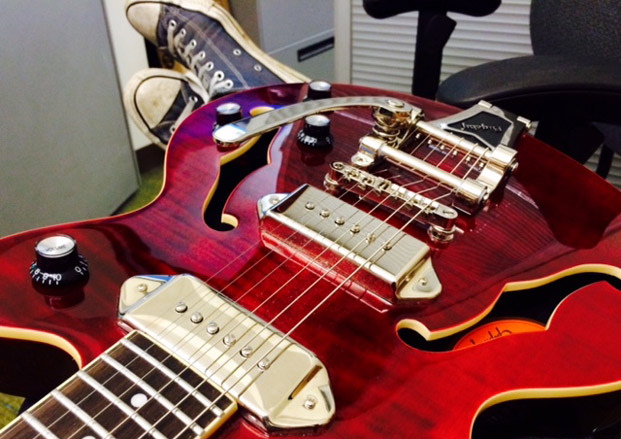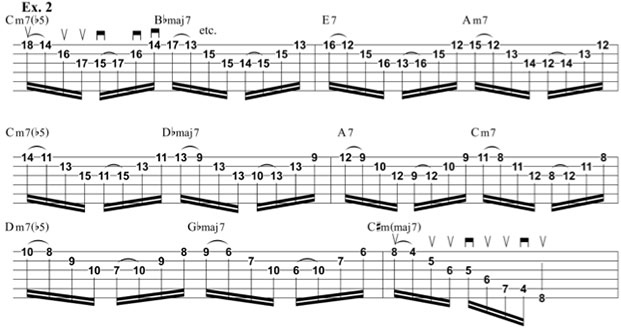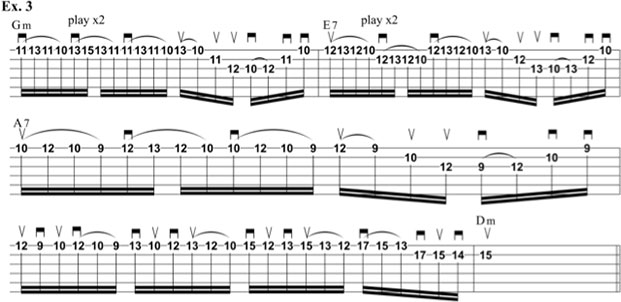Sweep Picking Seventh Arpeggios
A comprehensive look at seventh chords.

Welcome back, mortals! For this installment of Music of the Arcane, we will charge the nigh impenetrable musical bastion known as seventh chords.
In the previous lessons, we have largely eschewed hammer-ons and pull-offs in order to focus on the picking hand.
For this lesson’s featured eight-note pattern, however, we can increase our speed dramatically by applying hammers and pulls to these arpeggios.
EXAMPLE 1a demonstrates the fully diminished seventh arpeggio Yngwie Malmsteen introduced to an entire generation of shredders. Because of the symmetrical construction of this chord (all minor thirds), the shape doesn’t change as it moves up and down the neck. You can therefore achieve maximum velocity by moving three frets at a time while using the same fingering (EXAMPLE 1b).

Rather than give you a pedantic list of all the seventh chord types and inversions, I’ve constructed EXAMPLE 2 instead. This excerpt is challenging on multiple levels due to some tricky fingerings as well as the unique harmonic progression.

It is worth discussing the process of how I devised this excerpt as well. I came up with a series of compositional guidelines to follow that would ensure the creation of something a bit different:
1. The primary order of chords in the progression would be half-diminished 7 (minor 7b5), major 7, dominant 7 and minor 7.
All the latest guitar news, interviews, lessons, reviews, deals and more, direct to your inbox!
2. The first note of each arpeggio would descend chromatically by half step.
3. Each pair of chords would have a shared or common tone through the progression. For example, Cm7b5 and Bbmaj7 both have the same Bb (15th fret of the G), Bbmaj7 and E7 have the same D, and so on.
4. There would be no duplicate shapes or fingerings.
These guidelines are chosen arbitrarily of course, but I can say for certain that I wouldn’t have come up with EXAMPLE 2 if I hadn’t worked within these parameters. This process can be really useful in generating new ideas or breaking out of a compositional rut.
EXAMPLE 3 is another excerpt from an unreleased Lords of the Trident song that happens to feature this technique.

Notice how the arpeggios are sandwiched between legato and picking passages. This keeps the line from sounding too predictable and overly etude-like.
Additionally, a harmonic progression is implied while the fingering stays mostly in the same few frets, rather than jumping to a new area of the fretboard for each chord change. In case I haven’t mentioned it in the last few blogs, the construction of passages like this is the real reason that learning chord inversions is so valuable. Keep an eye out for this song sometime in the first half of 2017. Until we meet again, sharpen your steel and always fight the good fight!
Baron Taurean Helleshaar is a roaming sell sword and scholar of the forbidden “Music of the Arcane." He has formed an allegiance with the Lords of the Tridentwhile remaining in exile from his home in the Northern Kingdom. His mortal alter ego, Brian Koenig, is lead guitarist for the band Lords of the Trident and teaches music privately in Madison, Wisconsin. He was a founding member of Luna Mortis (Century Media) and has toured the U.S. and Canada. He holds a master's of music in composition from the University of North Carolina at Greensboro and a bachelor's of music in music theory and history from the University of Wisconsin Whitewater.
